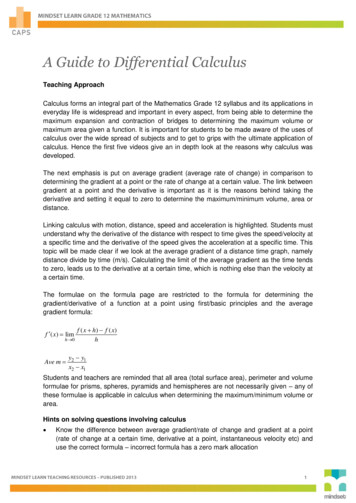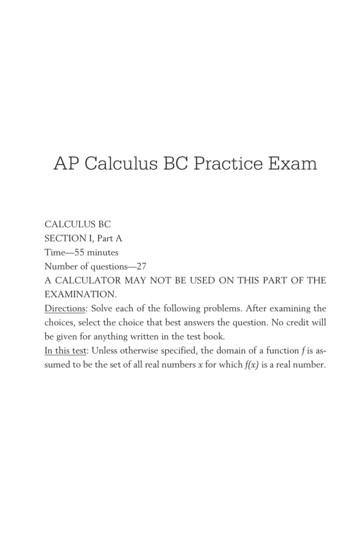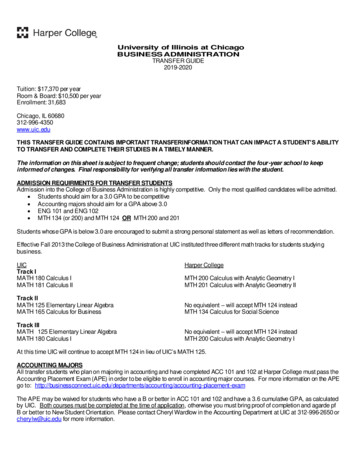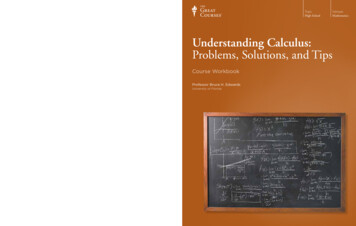
Transcription
The Project Gutenberg EBook of Calculus Made Easy, by Silvanus ThompsonThis eBook is for the use of anyone anywhere at no cost and withalmost no restrictions whatsoever.You may copy it, give it away orre-use it under the terms of the Project Gutenberg License includedwith this eBook or online at www.gutenberg.orgTitle: Calculus Made EasyBeing a very-simplest introduction to those beautifulmethods which are generally called by the terrifying namesof the DifferentiaAuthor: Silvanus ThompsonRelease Date: October 9, 2012 [EBook #33283]Language: EnglishCharacter set encoding: ISO-8859-1*** START OF THIS PROJECT GUTENBERG EBOOK CALCULUS MADE EASY ***
Produced by Andrew D. Hwang, Brenda Lewis and the OnlineDistributed Proofreading Team at http://www.pgdp.net (Thisfile was produced from images generously made availableby The Internet Archive/American Libraries.)transcriber’s noteMinor presentational changes, and minor typographical andnumerical corrections, have been made without comment. Alltextual changes are detailed in the LATEX source file.This PDF file is optimized for screen viewing, but may easily berecompiled for printing. Please see the preamble of the LATEXsource file for instructions.
CALCULUS MADE EASY
MACMILLAN AND CO., LimitedLONDON : BOMBAY : CALCUTTAMELBOURNETHE MACMILLAN COMPANYNEW YORK : BOSTON : CHICAGODALLAS : SAN FRANCISCOTHE MACMILLAN CO. OF CANADA, Ltd.TORONTO
CALCULUS MADE EASY:BEING A VERY-SIMPLEST INTRODUCTION TOTHOSE BEAUTIFUL METHODS OF RECKONINGWHICH ARE GENERALLY CALLED BY THETERRIFYING NAMES OF THEDIFFERENTIAL CALCULUSAND THEINTEGRAL CALCULUS.BYF. R. S.SECOND EDITION, ENLARGEDMACMILLAN AND CO., LIMITEDST. MARTIN’S STREET, LONDON
COPYRIGHT.First Edition 1910.Reprinted 1911 (twice), 1912, 1913.Second Edition 1914.
What one fool can do, another can.(Ancient Simian Proverb.)
PREFACE TO THE SECOND EDITION.The surprising success of this work has led the author to add a considerable number of worked examples and exercises. Advantage hasalso been taken to enlarge certain parts where experience showed thatfurther explanations would be useful.The author acknowledges with gratitude many valuable suggestionsand letters received from teachers, students, and—critics.October, 1914.
CONTENTS.ChapterPagePrologue . . . . . . . . . . . . . . . . . . . . . . . . . . . . . . . . . . . . . . .ixI. To deliver you from the Preliminary Terrors1II. On Different Degrees of Smallness . . . . . . . . . . .3III. On Relative Growings . . . . . . . . . . . . . . . . . . . . . . . . . .9IV. Simplest Cases . . . . . . . . . . . . . . . . . . . . . . . . . . . . . . . . . .17V. Next Stage. What to do with Constants . . . . . .25VI. Sums, Differences, Products and Quotients . . .34VII. Successive Differentiation . . . . . . . . . . . . . . . . . . . . .48VIII. When Time Varies . . . . . . . . . . . . . . . . . . . . . . . . . . . . . .52IX. Introducing a Useful Dodge . . . . . . . . . . . . . . . . . . .66X. Geometrical Meaning of Differentiation . . . . . .75XI. Maxima and Minima . . . . . . . . . . . . . . . . . . . . . . . . . . . . .91XII. Curvature of Curves . . . . . . . . . . . . . . . . . . . . . . . . . . . 109XIII. Other Useful Dodges . . . . . . . . . . . . . . . . . . . . . . . . . . 118XIV. On true Compound Interest and the Law of Organic Growth . . . . . . . . . . . . . . . . . . . . . . . . . . . . . 131vii
CALCULUS MADE EASYChapterviiiPageXV. How to deal with Sines and Cosines . . . . . . . . . . . 162XVI. Partial Differentiation . . . . . . . . . . . . . . . . . . . . . . . . 172XVII. Integration . . . . . . . . . . . . . . . . . . . . . . . . . . . . . . . . . . . . . 180XVIII. Integrating as the Reverse of Differentiating 189XIX. On Finding Areas by Integrating . . . . . . . . . . . . . . 204XX. Dodges, Pitfalls, and Triumphs . . . . . . . . . . . . . . . . 224XXI. Finding some Solutions . . . . . . . . . . . . . . . . . . . . . . . . . 232Table of Standard Forms . . . . . . . . . . . . . . . . . . . . . . . . 249Answers to Exercises. . . . . . . . . . . . . . . . . . . . . . . . . . . 252
PROLOGUE.Considering how many fools can calculate, it is surprising that itshould be thought either a difficult or a tedious task for any other foolto learn how to master the same tricks.Some calculus-tricks are quite easy. Some are enormously difficult.The fools who write the textbooks of advanced mathematics—and theyare mostly clever fools—seldom take the trouble to show you how easythe easy calculations are. On the contrary, they seem to desire toimpress you with their tremendous cleverness by going about it in themost difficult way.Being myself a remarkably stupid fellow, I have had to unteachmyself the difficulties, and now beg to present to my fellow fools theparts that are not hard. Master these thoroughly, and the rest willfollow. What one fool can do, another can.
CHAPTER I.TO DELIVER YOU FROM THE PRELIMINARYTERRORS.The preliminary terror, which chokes off most fifth-form boys fromeven attempting to learn how to calculate, can be abolished once forall by simply stating what is the meaning—in common-sense terms—ofthe two principal symbols that are used in calculating.These dreadful symbols are:(1) d which merely means “a little bit of.”Thus dx means a little bit of x; or du means a little bit of u. Ordinary mathematicians think it more polite to say “an element of,”instead of “a little bit of.” Just as you please. But you will find thatthese littleZ bits (or elements) may be considered to be indefinitely small.(2)which is merely a long S, and may be called (if you like) “thesum of.” ZZThus dx means the sum of all the little bits of x; or dt meansthe sum of all the little bits of t. Ordinary mathematicians call thissymbol “the integral of.” Now any fool can see that if x is consideredas made up of a lot of little bits, each of which is called dx, if youadd them all up together you get the sum of all the dx’s, (which is the
CALCULUS MADE EASY2same thing as the whole of x). The word “integral” simply means “thewhole.” If you think of the duration of time for one hour, you may (ifyou like) think of it as cut up into 3600 little bits called seconds. Thewhole of the 3600 little bits added up together make one hour.When you see an expression that begins with this terrifying symbol, you will henceforth know that it is put there merely to give youinstructions that you are now to perform the operation (if you can) oftotalling up all the little bits that are indicated by the symbols thatfollow.That’s all.
CHAPTER II.ON DIFFERENT DEGREES OF SMALLNESS.We shall find that in our processes of calculation we have to deal withsmall quantities of various degrees of smallness.We shall have also to learn under what circumstances we may consider small quantities to be so minute that we may omit them fromconsideration. Everything depends upon relative minuteness.Before we fix any rules let us think of some familiar cases. Thereare 60 minutes in the hour, 24 hours in the day, 7 days in the week.There are therefore 1440 minutes in the day and 10080 minutes in theweek.Obviously 1 minute is a very small quantity of time compared witha whole week. Indeed, our forefathers considered it small as compared with an hour, and called it “one minùte,” meaning a minutefraction—namely one sixtieth—of an hour. When they came to require still smaller subdivisions of time, they divided each minute into60 still smaller parts, which, in Queen Elizabeth’s days, they called“second minùtes” (i.e. small quantities of the second order of minuteness). Nowadays we call these small quantities of the second order ofsmallness “seconds.” But few people know why they are so called.Now if one minute is so small as compared with a whole day, how
4CALCULUS MADE EASYmuch smaller by comparison is one second!Again, think of a farthing as compared with a sovereign: it is barelyworth more than11000part. A farthing more or less is of precious littleimportance compared with a sovereign: it may certainly be regardedas a small quantity. But compare a farthing with 1000: relatively tothis greater sum, the farthing is of no more importance than11000of afarthing would be to a sovereign. Even a golden sovereign is relativelya negligible quantity in the wealth of a millionaire.Now if we fix upon any numerical fraction as constituting the proportion which for any purpose we call relatively small, we can easilystate other fractions of a higher degree of smallness. Thus if, for thepurpose of time,160be called a small fraction, then160of160(being asmall fraction of a small fraction) may be regarded as a small quantityof the second order of smallness. Or, if for any purpose we were to take 1 per cent. (i.e.1)100as a1) would be a10,0001and 1,000,000would besmall fraction, then 1 per cent. of 1 per cent. (i.e.small fraction of the second order of smallness;a small fraction of the third order of smallness, being 1 per cent. of1 per cent. of 1 per cent.Lastly, suppose that for some very precise purpose we should regard11,000,000as “small.” Thus, if a first-rate chronometer is not to loseor gain more than half a minute in a year, it must keep time withan accuracy of 1 part in 1, 051, 200. Now if, for such a purpose, we The mathematicians talk about the second order of “magnitude” (i.e. great-ness) when they really mean second order of smallness. This is very confusing tobeginners.
5DIFFERENT DEGREES OF SMALLNESSregard11,000,0001,1,000,000that is(or one millionth) as a small quantity, then11,000,000,000,00011,000,000of(or one billionth) will be a small quantityof the second order of smallness, and may be utterly disregarded, bycomparison.Then we see that the smaller a small quantity itself is, the morenegligible does the corresponding small quantity of the second orderbecome. Hence we know that in all cases we are justified in neglectingthe small quantities of the second—or third (or higher)—orders, if onlywe take the small quantity of the first order small enough in itself.But, it must be remembered, that small quantities if they occur inour expressions as factors multiplied by some other factor, may becomeimportant if the other factor is itself large. Even a farthing becomesimportant if only it is multiplied by a few hundred.Now in the calculus we write dx for a little bit of x. These thingssuch as dx, and du, and dy, are called “differentials,” the differentialof x, or of u, or of y, as the case may be. [You read them as dee-eks,or dee-you, or dee-wy.] If dx be a small bit of x, and relatively small ofitself, it does not follow that such quantities as x · dx, or x2 dx, or ax dxare negligible. But dx dx would be negligible, being a small quantityof the second order.A very simple example will serve as illustration.Let us think of x as a quantity that can grow by a small amount soas to become x dx, where dx is the small increment added by growth.The square of this is x2 2x · dx (dx)2 . The second term is notnegligible because it is a first-order quantity; while the third term is ofthe second order of smallness, being a bit of, a bit of x2 . Thus if we
6CALCULUS MADE EASY160took dx to mean numerically, say,be260of x, then the second term wouldof x2 , whereas the third term would be13600of x2 . This last termis clearly less important than the second. But if we go further and takedx to mean only11000of x, then the second term will bethe third term will be only11,000,00021000of x2 , whileof x2 .xxFig. 1.Geometrically this may be depicted as follows: Draw a square(Fig. 1) the side of which we will take to represent x. Now supposethe square to grow by having a bit dx added to its size each way.The enlarged square is made up of the original square x2 , the tworectangles at the top and on the right, each of which is of area x · dx(or together 2x · dx), and the little square at the top right-hand cornerwhich is (dx)2 . In Fig. 2 we have taken dx as quite a big fractionof x—about1.5But suppose we had taken it only1—about100thethickness of an inked line drawn with a fine pen. Then the little cornersquare will have an area of only110,000of x2 , and be practically invisible.Clearly (dx)2 is negligible if only we consider the increment dx to beitself small enough.Let us consider a simile.
7DIFFERENT DEGREES OF SMALLNESSxdxdxdxxxxx · dx(dx)2x2x · dxdxFig. 2.Fig. 3.Suppose a millionaire were to say to his secretary: next week I willgive you a small fraction of any money that comes in to me. Supposethat the secretary were to say to his boy: I will give you a small fractionof what I get. Suppose the fraction in each case to be1100part. Nowif Mr. Millionaire received during the next week 1000, the secretarywould receive 10 and the boy 2 shillings. Ten pounds would be asmall quantity compared with 1000; but two shillings is a small smallquantity indeed, of a very secondary order. But what would be thedisproportion if the fraction, instead of being110001,100had been settled atpart? Then, while Mr. Millionaire got his 1000, Mr. Secretarywould get only 1, and the boy less than one farthing!The witty Dean Swift once wrote:“So, Nat’ralists observe, a Flea“Hath smaller Fleas that on him prey.“And these have smaller Fleas to bite ’em,“And so proceed ad infinitum.” On Poetry: a Rhapsody (p. 20), printed 1733—usually misquoted.
CALCULUS MADE EASY8An ox might worry about a flea of ordinary size—a small creature ofthe first order of smallness. But he would probably not trouble himselfabout a flea’s flea; being of the second order of smallness, it would benegligible. Even a gross of fleas’ fleas would not be of much account tothe ox.
CHAPTER III.ON RELATIVE GROWINGS.All through the calculus we are dealing with quantities that are growing, and with rates of growth. We classify all quantities into two classes:constants and variables. Those which we regard as of fixed value, andcall constants, we generally denote algebraically by letters from the beginning of the alphabet, such as a, b, or c; while those which we consideras capable of growing, or (as mathematicians say) of “varying,” we denote by letters from the end of the alphabet, such as x, y, z, u, v, w,or sometimes t.Moreover, we are usually dealing with more than one variable atonce, and thinking of the way in which one variable depends on theother: for instance, we think of the way in which the height reachedby a projectile depends on the time of attaining that height. Or weare asked to consider a rectangle of given area, and to enquire how anyincrease in the length of it will compel a corresponding decrease in thebreadth of it. Or we think of the way in which any variation in theslope of a ladder will cause the height that it reaches, to vary.Suppose we have got two such variables that depend one on theother. An alteration in one will bring about an alteration in the other,because of this dependence. Let us call one of the variables x, and the
10CALCULUS MADE EASYother that depends on it y.Suppose we make x to vary, that is to say, we either alter it orimagine it to be altered, by adding to it a bit which we call dx. We arethus causing x to become x dx. Then, because x has been altered,y will have altered also, and will have become y dy. Here the bit dymay be in some cases positive, in others negative; and it won’t (exceptby a miracle) be the same size as dx.Take two examples.(1) Let x and y be respectively the base and the height of a rightangled triangle (Fig. 4), of which the slope of the other side is fixeddyyy30 xdxFig. 4.at 30 . If we suppose this triangle to expand and yet keep its anglesthe same as at first, then, when the base grows so as to become x dx,the height becomes y dy. Here, increasing x results in an increaseof y. The little triangle, the height of which is dy, and the base of whichis dx, is similar to the original triangle; and it is obvious that the valuedyyof the ratiois the same as that of the ratio . As the angle is 30 dxxit will be seen that heredy1 .dx1.73
ON RELATIVE GROWINGS11(2) Let x represent, in Fig. 5, the horizontal distance, from a wall,of the bottom end of a ladder, AB, of fixed length; and let y be theByOxAFig. 5.height it reaches up the wall. Now y clearly depends on x. It is easy tosee that, if we pull the bottom end A a bit further from the wall, thetop end B will come down a little lower. Let us state this in scientificlanguage. If we increase x to x dx, then y will become y dy; that is,when x receives a positive increment, the increment which results to yis negative.Yes, but how much? Suppose the ladder was so long that when thebottom end A was 19 inches from the wall the top end B reached just15 feet from the ground. Now, if you were to pull the bottom end out1 inch more, how much would the top end come down? Put it all intoinches: x 19 inches, y 180 inches. Now the increment of x whichwe call dx, is 1 inch: or x dx 20 inches.
CALCULUS MADE EASY12How much will y be diminished? The new height will be y dy. Ifwe work out the height by Euclid I. 47, then we shall be able to findhow much dy will be. The length of the ladder isp(180)2 (19)2 181 inches.Clearly then, the new height, which is y dy, will be such that(y dy)2 (181)2 (20)2 32761 400 32361, y dy 32361 179.89 inches.Now y is 180, so that dy is 180 179.89 0.11 inch.So we see that making dx an increase of 1 inch has resulted inmaking dy a decrease of 0.11 inch.And the ratio of dy to dx may be stated thus:0.11dy .dx1It is also easy to see that (except in one particular position) dy willbe of a different size from dx.Now right through the differential calculus we are hunting, hunting,hunting for a curious thing, a mere ratio, namely, the proportion whichdy bears to dx when both of them are indefinitely small.dywhendxy and x are related to each other in some way, so that whenever x variesIt should be noted here that we can only find this ratioy does vary also. For instance, in the first example just taken, if thebase x of the triangle be made longer, the height y of the trianglebecomes greater also, and in the second example, if the distance x ofthe foot of the ladder from the wall be made to increase, the height y
ON RELATIVE GROWINGS13reached by the ladder decreases in a corresponding manner, slowly atfirst, but more and more rapidly as x becomes greater. In these casesthe relation between x and y is perfectly definite, it can be expressedy tan 30 and x2 y 2 l2 (where l is themathematically, beingxdylength of the ladder) respectively, andhas the meaning we found indxeach case.If, while x is, as before, the distance of the foot of the ladder fromthe wall, y is, instead of the height reached, the horizontal length ofthe wall, or the number of bricks in it, or the number of years since itwas built, any change in x would naturally cause no change whateverdyhas no meaning whatever, and it is not possiblein y; in this casedxto find an expression for it. Whenever we use differentials dx, dy,dz, etc., the existence of some kind of relation between x, y, z, etc., isimplied, and this relation is called a “function” in x, y, z, etc.; the twoyexpressions given above, for instance, namely tan 30 and x2 y 2 xl2 , are functions of x and y. Such expressions contain implicitly (thatis, contain without distinctly showing it) the means of expressing eitherx in terms of y or y in terms of x, and for this reason they are calledimplicit functions in x and y; they can be respectively put into theformsandyy x tan 30 or x tan 30 p y l2 x2 or x l2 y 2 .These last expressions state explicitly (that is, distinctly) the valueof x in terms of y, or of y in terms of x, and they are for this reasoncalled explicit functions of x or y. For example x2 3 2y 7 is an
CALCULUS MADE EASY14x2 10(explicitimplicit function in x and y; it may be written y 2 function of x) or x 2y 10 (explicit function of y). We see thatan explicit function in x, y, z, etc., is simply something the value ofwhich changes when x, y, z, etc., are changing, either one at the timeor several together. Because of this, the value of the explicit functionis called the dependent variable, as it depends on the value of the othervariable quantities in the function; these other variables are called theindependent variables because their value is not determined from thevalue assumed by the function. For example, if u x2 sin θ, x and θare the independent variables, and u is the dependent variable.Sometimes the exact relation between several quantities x, y, z either is not known or it is not convenient to state it; it is only known,or convenient to state, that there is some sort of relation between thesevariables, so that one cannot alter either x or y or z singly withoutaffecting the other quantities; the existence of a function in x, y, zis then indicated by the notation F (x, y, z) (implicit function) or byx F (y, z), y F (x, z) or z F (x, y) (explicit function). Sometimesthe letter f or φ is used instead of F , so that y F (x), y f (x) andy φ(x) all mean the same thing, namely, that the value of y dependson the value of x in some way which is not stated.dy“the differential coefficient of y with respectWe call the ratiodxto x.” It is a solemn scientific name for this very simple thing. Butwe are not going to be frightened by solemn names, when the thingsthemselves are so easy. Instead of being frightened we will simply pronounce a brief curse on the stupidity of giving long crack-jaw names;and, having relieved our minds, will go on to the simple thing itself,
ON RELATIVE GROWINGS15dy.dxIn ordinary algebra which you learned at school, you were alwaysnamely the ratiohunting after some unknown quantity which you called x or y; or sometimes there were two unknown quantities to be hunted for simultaneously. You have now to learn to go hunting in a new way; the fox beingnow neither x nor y. Instead of this you have to hunt for this curiousdydy. The process of finding the value ofis called “difcub calleddxdxferentiating.” But, remember, what is wanted is the value of this ratiowhen both dy and dx are themselves indefinitely small. The true valueof the differential coefficient is that to which it approximates in thelimiting case when each of them is considered as infinitesimally minute.dy.Let us now learn how to go in quest ofdx
CALCULUS MADE EASY16NOTE TO CHAPTER III.How to read Differentials.It will never do to fall into the schoolboy error of thinking that dxmeans d times x, for d is not a factor—it means “an element of” or “abit of” whatever follows. One reads dx thus: “dee-eks.”In case the reader has no one to guide him in such matters it mayhere be simply said that one reads differential coefficients in the following way. The differential coefficientdyis read “dee-wy by dee-eks,” or “dee-wy over dee-eks.”dxduis read “dee-you by dee-tee.”So alsodtSecond differential coefficients will be met with later on. They arelike this:d2 y; which is read “dee-two-wy over dee-eks-squared,”dx2and it means that the operation of differentiating y with respect to xhas been (or has to be) performed twice over.Another way of indicating that a function has been differentiated isby putting an accent to the symbol of the function. Thus if y F (x),which means that y is some unspecifiedfunction of x (see p. 13), we may d F (x)write F 0 (x) instead of. Similarly, F 00 (x) will mean that thedxoriginal function F (x) has been differentiated twice over with respectto x.
CHAPTER IV.SIMPLEST CASES.Now let us see how, on first principles, we can differentiate some simplealgebraical expression.Case 1.Let us begin with the simple expression y x2 . Now rememberthat the fundamental notion about the calculus is the idea of growing.Mathematicians call it varying. Now as y and x2 are equal to oneanother, it is clear that if x grows, x2 will also grow. And if x2 grows,then y will also grow. What we have got to find out is the proportionbetween the growing of y and the growing of x. In other words our taskis to find out the ratio between dy and dx, or, in brief, to find the valuedy.ofdxLet x, then, grow a little bit bigger and become x dx; similarly,y will grow a bit bigger and will become y dy. Then, clearly, it will stillbe true that the enlarged y will be equal to the square of the enlarged x.Writing this down, we have:y dy (x dx)2 .
CALCULUS MADE EASY18Doing the squaring we get:y dy x2 2x · dx (dx)2 .What does (dx)2 mean? Remember that dx meant a bit—a littlebit—of x. Then (dx)2 will mean a little bit of a little bit of x; thatis, as explained above (p. 4), it is a small quantity of the second orderof smallness. It may therefore be discarded as quite inconsiderable incomparison with the other terms. Leaving it out, we then have:y dy x2 2x · dx.Now y x2 ; so let us subtract this from the equation and we haveleftdy 2x · dx.Dividing across by dx, we finddy 2x.dxNow this is what we set out to find. The ratio of the growing of yto the growing of x is, in the case before us, found to be 2x.dyis the result of differentiating y with respect to x. Difdxferentiating means finding the differential coefficient. Suppose we had some other N.B.—This ratiofunction of x, as, for example, u 7x2 3. Then if we were told to differentiate thisdud(7x2 3)with respect to x, we should have to find, or, what is the same thing,.dxdxOn the other hand, we may have a case in which time was the independent variable(see p. 14), such as this: y b 21 at2 . Then, if we were told to differentiate it, thatmeans we must find its differential coefficient with respect to t. So that then ourd(b 12 at2 )dybusiness would be to try to find, that is, to find.dtdt
SIMPLEST CASES19Numerical example.Suppose x 100 and y 10, 000. Then let x grow till it becomes101 (that is, let dx 1). Then the enlarged y will be 101 101 10, 201. But if we agree that we may ignore small quantities of thesecond order, 1 may be rejected as compared with 10, 000; so we mayround off the enlarged y to 10, 200. y has grown from 10, 000 to 10, 200;the bit added on is dy, which is therefore 200.200dy 200. According to the algebra-working of the previousdx1dyparagraph, we find 2x. And so it is; for x 100 and 2x 200.dxBut, you will say, we neglected a whole unit.Well, try again, making dx a still smaller bit.Try dx 1.10Then x dx 100.1, and(x dx)2 100.1 100.1 10, 020.01.Now the last figure 1 is only one-millionth part of the 10, 000, andis utterly negligible; so we may take 10, 020 without the little decimaldy20at the end. And this makes dy 20; and 200, which isdx0.1still the same as 2x.Case 2.Try differentiating y x3 in the same way.We let y grow to y dy, while x grows to x dx.Then we havey dy (x dx)3 .Doing the cubing we obtainy dy x3 3x2 · dx 3x(dx)2 (dx)3 .
CALCULUS MADE EASY20Now we know that we may neglect small quantities of the secondand third orders; since, when dy and dx are both made indefinitelysmall, (dx)2 and (dx)3 will become indefinitely smaller by comparison.So, regarding them as negligible, we have left:y dy x3 3x2 · dx.But y x3 ; and, subtracting this, we have:dy 3x2 · dx,dy 3x2 .dxandCase 3.Try differentiating y x4 . Starting as before by letting both y and xgrow a bit, we have:y dy (x dx)4 .Working out the raising to the fourth power, we gety dy x4 4x3 dx 6x2 (dx)2 4x(dx)3 (dx)4 .Then striking out the terms containing all the higher powers of dx,as being negligible by comparison, we havey dy x4 4x3 dx.Subtracting the original y x4 , we have leftdy 4x3 dx,anddy 4x3 .dx
SIMPLEST CASES21Now all these cases are quite easy. Let us collect the results to see ifwe can infer any general rule. Put them in two columns, the values of ydyin the other: thusin one and the corresponding values found fordxydydxx22xx33x2x44x3Just look at these results: the operation of differentiating appearsto have had the effect of diminishing the power of x by 1 (for examplein the last case reducing x4 to x3 ), and at the same time multiplying bya number (the same number in fact which originally appeared as thepower). Now, when you have once seen this, you might easily conjecturehow the others will run. You would expect that differentiating x5 wouldgive 5x4 , or differentiating x6 would give 6x5 . If you hesitate, try oneof these, and see whether the conjecture comes right.Try y x5 .Theny dy (x dx)5 x5 5x4 dx 10x3 (dx)2 10x2 (dx)3 5x(dx)4 (dx)5 .Neglecting all the terms containing small quantities of the higherorders, we have lefty dy x5 5x4 dx,
CALCULUS MADE EASYand subtracting22y x5 leaves usdy 5x4 dx,whencedy 5x4 , exactly as we supposed.dxFollowing out logically our observation, we should conclude that ifwe want to deal with any higher power,—call it n—we could tackle itin the same way.y xn ,Letthen, we should expect to find thatdy nx(n 1) .dxFor example, let n 8, then y x8 ; and differentiating it woulddy 8x7 .givedxAnd, indeed, the rule that differentiating xn gives as the result nxn 1is true for all cases where n is a whole number and positive. [Expanding(x dx)n by the binomial theorem will at once show this.] But thequestion whether it is true for cases where n has negative or fractionalvalues requires further consideration.Case of a negative power.Let y x 2 . Then proceed as before:y dy (x dx) 2 2dx 2 x1 .x
SIMPLEST CASES23Expanding this by the binomial theorem (see p. 137), we get#" 22(2 1)dx2dx etc. x 2 1 x1 2x x 2 2x 3 · dx 3x 4 (dx)2 4x 5 (dx)3 etc.So, neglecting the small quantities of higher orders of smallness, wehave:y dy x 2 2x 3 · dx.Subtracting the original y x 2 , we finddy 2x 3 dx,dy 2x 3 .dxAnd this is still in accordance with the rule inferred above.Case of
calculus made easy: being a very-simplest introduction to those beautiful methods of reckoning which are generally called by the terrifying names of the differential calculus and the integral calculus. by f. r. s. second edition, enlarged macmillan and co., limited st. martin's street, london 1914










